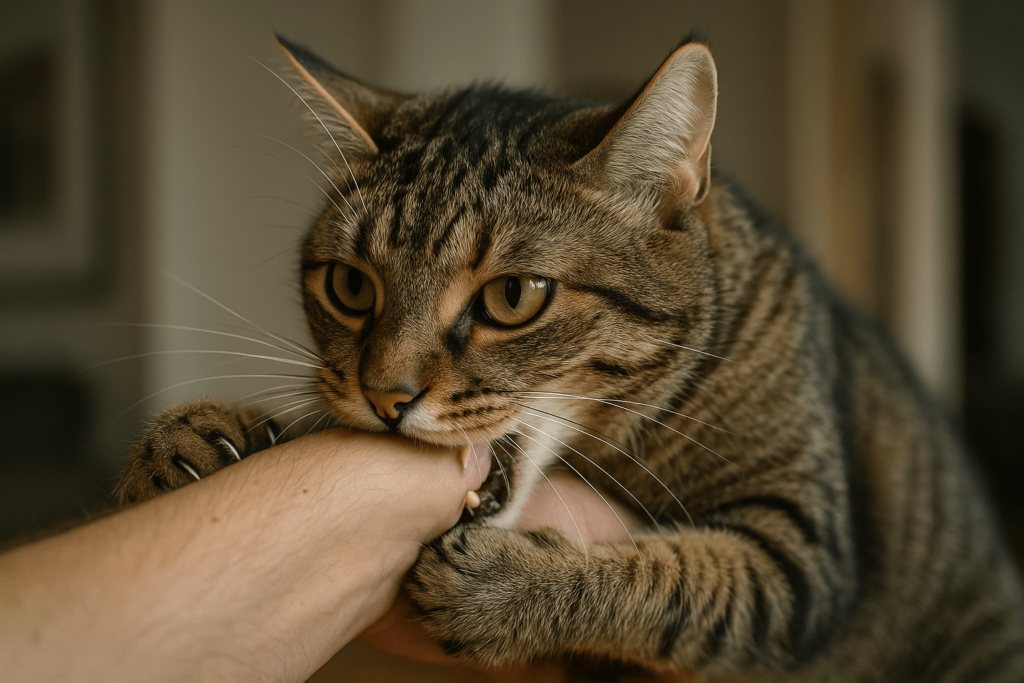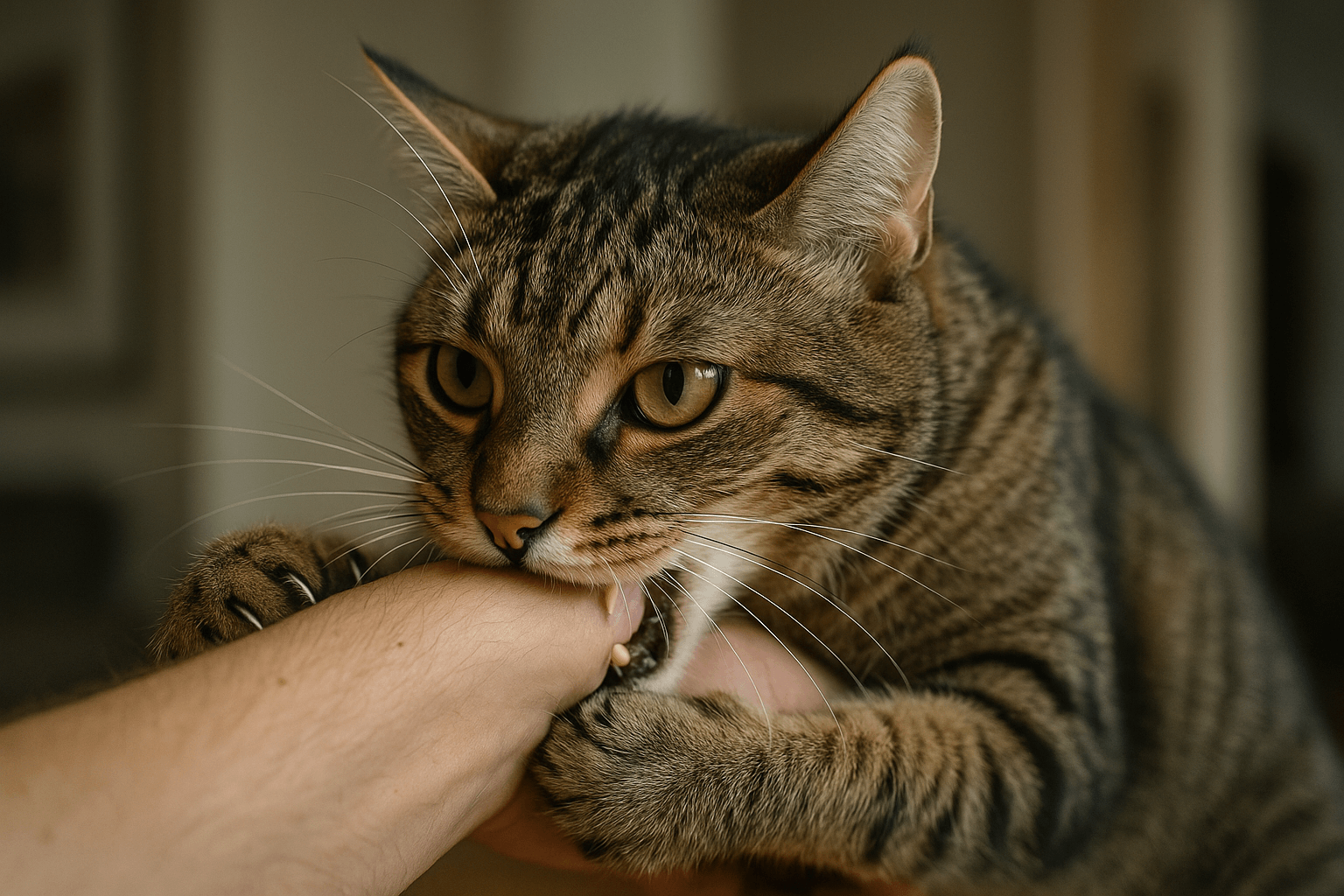My Cat Bites Me and Holds On: Why It Happens and How to Stop It
Your cat nuzzles you one moment—then suddenly, out of nowhere, they clamp down with their teeth and refuse to let go. It’s startling. Painful. And deeply confusing. Why would your loving companion do this? This isn’t random aggression. It’s communication. And understanding why your cat bites and holds on is the first step toward healing the bond between you.
The Root Causes Behind Biting and Holding On
When your cat latches on and won’t release, it’s rarely about malice. Their behavior is driven by instinct, emotion, or physical need. Here’s what’s really happening:
Play Aggression:
Kittens and young cats often bite and hold during play, mistaking hands or feet for prey. This behavior is learned from littermates and can persist if not redirected.Overstimulation:
Cats have a low tolerance for prolonged petting. A gentle stroke can become too much, triggering a bite-and-hold reflex as a way to say “stop.”Fear or Defensive Behavior:
If your cat feels trapped, startled, or threatened, they may bite and hold to create distance or escape—especially during handling or vet visits.Attention-Seeking:
Some cats learn that biting and holding gets a reaction—whether it’s yelling, moving, or even giving them treats. They repeat it because it works.Medical Discomfort:
Pain from arthritis, dental issues, or skin conditions can make your cat sensitive to touch. A gentle pet might trigger a defensive bite-and-hold response.
This isn’t your cat being “bad.” It’s your cat trying to express something they can’t say in words. Recognizing the trigger is the key to change.

How to Tell the Difference Between Play, Fear, and Pain
Not all bites are the same. The context, intensity, and body language tell the real story. Here’s how to decode what your cat is feeling:
Play Bites:
Light, quick nips often accompanied by pouncing, tail flicking, or crouching. The cat releases quickly and may resume play.Fear-Based Bites:
Teeth clamp down hard and hold. Ears flatten, pupils dilate, body is tense, and the cat may hiss or try to flee. This is a survival response.Overstimulation Bites:
Sudden bite after a period of petting. Often preceded by tail thumping, skin rippling, or ear twitching. No warning growl—just a snap.Pain-Related Bites:
Bite occurs in a specific area (e.g., lower back, belly, or mouth). The cat avoids touch there normally and may flinch or cry out.Attention-Seeking Bites:
Happens when you’re distracted—reading, on the phone, or walking away. The bite is deliberate, aimed at your hand or arm to force interaction.
Understanding the type of bite helps you respond correctly. Punishing a fearful cat makes it worse. Ignoring an overstimulated cat teaches them to escalate.
Check this guide 👉Why Does My Cat Bite My Other Cats Ear? Best 7 Expert Tips!
Check this guide 👉What Is the Best Antibiotic for Cat Bites? Best 7 Expert Tips!
Check this guide 👉Why Does My Cat Bite My Fingers? Best 7 Expert Tips!
| Bite Type | Key Signs to Watch For |
|---|---|
| Play Aggression | Bites during play, no growling, tail flicks, pounces after biting, releases quickly |
| Overstimulation | Sudden bite after petting, skin twitches, ears flatten, no prior warning, often on back or tail base |
| Fear/Defensive | Hard hold, hissing, dilated pupils, crouched posture, tries to escape, may bite when restrained |
| Pain-Related | Bites only when touched in specific area, avoids contact, may yowl, limps, or shows other signs of discomfort |
| Attention-Seeking | Bites when ignored, targets hands or arms, repeats if rewarded with attention, calm before and after |
What Not to Do When Your Cat Bites and Holds On
It’s natural to react—yelling, pulling away, swatting, even scolding. But these responses often make the problem worse. Here’s what to avoid at all costs:
Never Pull Your Hand Away:
Yanking triggers the cat’s prey instinct to clamp down harder. It can cause deeper injury and reinforce the behavior.Don’t Hit or Swat:
Physical punishment creates fear, not understanding. Your cat may learn to associate your hands with danger.Avoid Yelling or Shaking:
Loud noises increase stress and can make your cat feel more threatened, leading to more defensive biting.Don’t Ignore Repeated Bites:
If you ignore the behavior, your cat learns it’s acceptable. Consistency is key—even if the bite seems small.Never Use Your Hands as Toys:
Playing with fingers or toes teaches your cat that body parts are prey. Always use wand toys or balls instead.
Reacting emotionally only fuels the cycle. Calm, consistent responses break it.
How to Stop the Behavior: Step-by-Step Strategies
Changing your cat’s biting habit takes patience—but it’s absolutely possible. Follow these proven steps to create lasting change.
End Play Immediately:
If your cat bites during play, freeze, stop moving, and walk away quietly. No eye contact. No reaction. This teaches them biting ends fun.Use Toys, Not Hands:
Always engage with interactive toys—feather wands, motorized mice, or laser pointers. Keep your hands out of the equation.Recognize Warning Signs:
Learn your cat’s pre-bite signals: tail lashing, skin rippling, dilated pupils. Stop petting before the bite happens.Create Safe Spaces:
Give your cat a quiet room with bedding, toys, and hiding spots. Let them retreat when overstimulated.Reward Calm Behavior:
Give treats, gentle pets, or praise when your cat is relaxed near you. Reinforce the behavior you want—not the one you fear.
Progress isn’t linear. Some days will be better than others. But consistency builds trust—and trust stops the bites.
When to Suspect a Medical Problem
Sometimes, biting and holding isn’t behavioral—it’s biological. If your cat suddenly starts biting more often or with unusual intensity, consider a vet visit.
Sudden Change in Behavior:
If your cat never bit before and now does frequently, pain or illness is likely.Biting Only in One Area:
If they bite when you touch their back, belly, or jaw, they may have arthritis, dental pain, or a skin condition.Other Symptoms Present:
Lethargy, hiding, loss of appetite, excessive grooming, or vocalizing when touched are red flags.Biting During Grooming or Handling:
If your cat resists being touched at the vet or during nail trims, this could indicate chronic discomfort.No Improvement After Behavioral Training:
If you’ve tried everything for 4–6 weeks with no change, it’s time for diagnostics—bloodwork, X-rays, or a pain assessment.
A vet can rule out hidden conditions like hyperesthesia, dental disease, or neurological issues. Don’t assume it’s “just personality.”
Training Your Cat to Be Gentle: Positive Reinforcement Techniques
You can teach your cat to interact gently. It’s not about punishment—it’s about reward. Here’s how:
The “Hand is a Rock” Method:
When your cat bites, go completely still—no movement, no sound. Your hand becomes a boring object. The moment they release, offer a treat.Clicker Training for Gentle Touch:
Click and reward when your cat touches your hand with their nose or paw—never with teeth. Gradually increase the duration of calm contact.The “Three-Second Rule”:
Pet your cat for three seconds, then stop. If they stay calm, give a treat. If they bite, stop petting. Repeat daily.Desensitization to Handling:
Gently touch one area (e.g., shoulder) for one second, then stop. Reward. Gradually increase time and location over weeks.Use High-Value Rewards:
Freeze-dried chicken, tuna flakes, or catnip treats work best. The reward must be worth more than the bite.
Training takes time—but every gentle interaction rebuilds your cat’s trust in your hands.
Creating a Cat-Friendly Environment to Reduce Biting
A calm home reduces stress—and stress is a major trigger for biting. Make your space work for your cat’s needs.
Provide Vertical Space:
Cat trees, shelves, and window perches give them control and reduce anxiety.Offer Multiple Resources:
Separate food bowls, litter boxes, and sleeping areas prevent resource guarding and tension.Maintain Routine:
Cats thrive on predictability. Feed, play, and sleep at the same times daily.Minimize Loud Noises:
Vacuuming, doorbells, or yelling can trigger fear-based aggression. Use white noise or calming music.Use Pheromone Diffusers:
Feliway mimics calming feline facial pheromones and can reduce stress-related biting.
A peaceful environment isn’t a luxury—it’s a necessity for a cat who’s trying to feel safe.
FAQ: My Cat Bites Me and Holds On
Why does my cat bite me and not my partner?
Cats often bond more intensely with one person and may test boundaries with them. They may also find your movements or scent more stimulating.
Is it normal for my kitten to bite and hold?
Yes—especially during play. But if it continues past 6–8 months without redirection, it becomes a learned habit that needs correction.
Can I use bitter spray on my skin to stop biting?
Not recommended. Skin is sensitive, and sprays can irritate. Focus on redirecting behavior instead of masking it.
Will neutering/spaying stop my cat from biting?
It may reduce aggression related to hormones, but not if the biting is due to play, overstimulation, or fear. It’s not a cure-all.
My cat bites gently—should I still be concerned?
Yes. Even “love bites” teach your cat that biting is acceptable. It can escalate, especially around children or guests.
Respect the Bite—But Don’t Accept It
Your cat isn’t trying to hurt you. They’re trying to communicate—whether it’s “I’m overstimulated,” “I’m scared,” or “I need to play.” The bite is their language. And you? You’re the translator.
This isn’t about breaking your cat’s spirit. It’s about teaching them that your hands are safe, your lap is calm, and play happens with toys—not toes.
It takes patience. It takes consistency. And above all, it takes love—not punishment.
Canned Pumpkin for Cat Diarrhea: Best 7 Expert Tips! Natural remedy to firm stools, soothe upset bellies, and support gut health safely.
Can a Cat Give You Scabies? Best 7 Expert Tips! Discover the truth about feline mites, human skin risks, and how to protect yourself—without panic.
Cat Flea vs Human Flea: Best 7 Expert Tips! Discover the truth about bites, species, and how to eliminate infestations for good.
Weird Cat Behaviors: Best 7 Expert Tips! Discover why cats do strange things—and how to understand, not punish, their instincts for a happier home.





